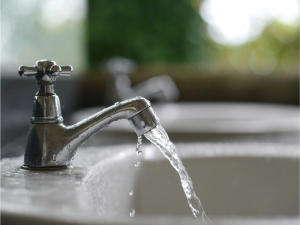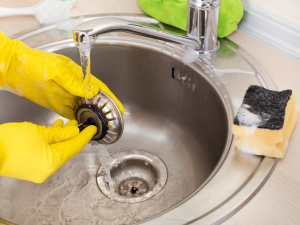A leaky faucet can be a nuisance. The constant dripping sound and puddles of water under the sink are enough to push anyone over the edge. Broken faucets can even turn into an even bigger problem if not addressed. For instance, you might step on the water puddles and trip. Similarly, leaking water can cause water damage to the floor or any equipment near the sink, not to forget the health risks posed by stagnant water in a home. Also, those wasted drops finally add up and reflect on your water bill.
Luckily, a broken faucet is relatively easy to fix. It is also inexpensive and does not take much time. All you need is a few handy tools and equipment. However, ensure you identify the type of faucet in your home and have all tools and equipment ready. There are four common types of faucets: Disc, Cartridge, Compression Washer, and Ball faucets. The compression washer faucets are the oldest design and are mostly found in older homes.
But first, let’s see what could have caused the broken faucet.
Corrosion of parts within the faucet– You may be dealing with corroded parts of the faucet causing deformation of the water inlet ports. If corroded, seals and washers on the cartridge or faucet stem won’t seal property leading to water leaks. If you notice that parts of the faucet are corroded, the only solution is to replace the entire faucet.
Mineral build-up– Over time, scales build up in the inner parts of the faucet, more so if you are using hard water in the homestead. The mineral build-up interferes with the ability of the faucet to seal the water inlets. This problem can be solved by cleaning up the scale. And in instances where the build-up is extreme, you may be forced to replace the faucet.
Worn out O-rings– If the faucet is leaking around the base of the spout, the O-rings underneath the spout assembly could be broken.
To fix a broken faucet, you will need:
- Channel-lock pliers
- Flathead screwdriver
- Scouring pad
- Adjustable wrench
- Allen wrenches
- Phillips-head screwdriver
- Washers and seals
- White vinegar
1. Start by shutting off the water
If you begin to repair the broken faucet without shutting off the water, you could have a flooded home. Look for the fixture shutoff valves underneath the sink and turn the handles clockwise. If the faucet does not have fixture shut-off valves, turn off the water from the main water supply in the homestead. Before you start disassembling the faucet, verify that the water supply is turned off by turning on the faucet. Since the faucet has small parts, cover the drain with a cloth or stopper to avoid losing the small parts down the drain.
2. Takedown the faucet handles
This depends on the type of faucet that you have. If you have a standard faucet, use a flathead screwdriver to remove the caps on the handle. Unscrew the screws and pull the handles. If the faucet is held in place by hex setscrew, loosen it and lift it off with an upward pull. If extremely corroded, some screws may be difficult to remove. In this case, lubricating the parts with spray oil will loosen the parts. While you may be tempted to remove the handles with pliers, you will only damage the finish. Pay close attention to the orientation and order in which you remove the parts. If you think you might forget, use a digital camera to record each step.
3. Remove the cartridge or valve stem
Once you remove the faucet handle, the cartridge or inner valve stem will be revealed. The technique of removing the cartridge varies depending on the type of faucet. If you have a compression faucet, you can unscrew the brass valve stem from the valve body. For a cartridge faucet, remove the brass or plastic cartridge based on the manufacturers’ instructions on how to remove it.
4. Carefully inspect all parts of the faucet
Ensure you inspect all parts of the faucet, taking notes of any breakages. If the faucet has rubber washers, ring-shaped rubber seals, and rubber O-rings, ensure you carefully inspect them. Replace all the old or damaged parts. While it is always a good idea to replace all the removable parts, it may not be necessary if you notice that only one part is damaged. Also, most manufacturers sell kits that have all the vital faucet parts. If you are unsure of the exact duplicates, take the old parts to the hardware parts and ask for the replacements.
5. Use vinegar to clean the valves
Inspecting the valves and cleaning them is a vital step especially when they have roughened or have a build-up of mineral scale. Soak the valve seat on the vinegar, let it sit for a few minutes, and use a nylon pad to clean the build-up. Ensure you are left with a smooth and shiny valve.
6. You can now reassemble the faucet
This should be done carefully, reversing the order in which you disassembled the faucet. Once done, turn on the water supply and inspect the faucet for leaks.
Tired of constant faucet repairs? Here are some extra tips for maintaining your faucets.
- Faucets require daily maintenance– Though little, the daily care and maintenance are vital. Using a mild cleanser and damp cloth, clean the faucet as well as the areas around it. Be sure to read the labels and directions on the recommended cleaning products. Small faucet components such as seats and springs wear and tear, necessitating regular replacement.
- Remove mineral deposits– Hard water has a high mineral content which leaves lime deposits on your faucet. While it can be stubborn to remove, a mildly abrasive scrub or vinegar will do the trick.
- Clean the aerator– Aerators mix air and water, ensuring a smooth flow from the faucet. Aerator parts: screen insert, housing, and rubber washer are often ignored. These should be cleaned or replaced as often as needed.
Bottomline
While most faucet issues can be solved with a quick repair, some require complete replacements. If you have repaired the faucet several times and still experience the same problem, another leak could be the cue to replace the entire faucet. If you have a compression faucet, consider replacing it with a modern cartridge faucet other than attempting to repair it. Also, if you cannot find the replacement parts, the faucet is leaking from multiple areas and the inner parts are extremely corroded, an entire replacement may be necessary. Schedule an appointment with a plumbing professional.




